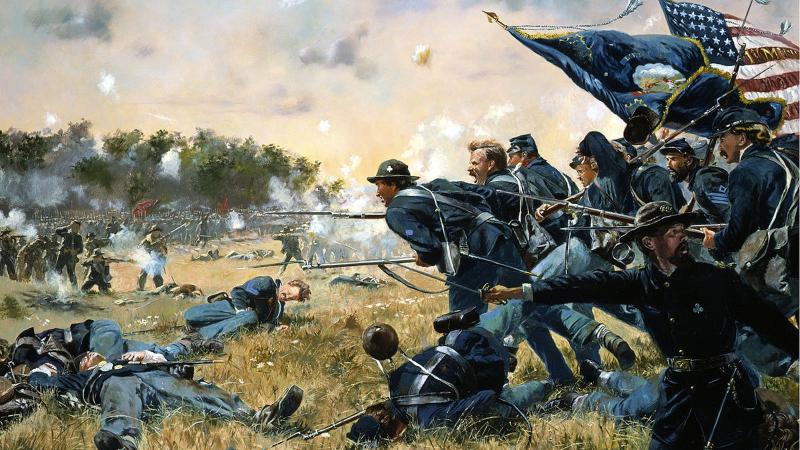Sacrifice: Remembering the 1st Minnesota at Gettysburg


I was watching the 4th of July fireworks from Washington D.C. and thinking back on the history of the US and of my family which has a military history dating back hundreds of years. I remembered this article from a few years ago and being from Minnesota it always stuck in my mind.
Historians agree that if it wasn't for the 1st Minnesota at Gettysburg there might not be a union today.
One of my ancestors was with the Company K, 1st Michigan Sharpshooters, and fought at the ''Battle of the Crater'' among many other major engagements which are more than ironic, thirty-five years later my grandfather fought against the US 3rd Infantry at the Battle of Sugar Point, Leech Lake, MN. 1898 in what is considered the last of the Indian wars.
Link to Company K https://www.michiganradio.org/offbeat/2017-08-23/the-story-of-company-k-native-americans-from-michigan-who-saw-tough-action-in-the-civil-war
link to the Battle of Sugar Point...https://www.leechlakenews.com/2018/10/05/on-this-day-in-history-the-battle-of-sugar-point/
History can take strange paths.

More than a century and a half later, the nation they fought and died for remains, still imperfect, but still here.
Heroism seldom occurs without a mistake, and it was no different around 4 pm on July 2, 1863. Union General Sickles, a political appointee without a military background, advanced his men without authorization to higher ground 1000 meters ahead of his original position, creating a gap in the Union lines. Cemetery Ridge was now vulnerable, and Confederate forces poured into the half-mile-wide opening.
The Union held the veteran troops in reserve. Green troops in the front because green troops run instead of holding their lines. Veterans stand their ground. No regiment was more veteran than the 1st Minnesota. Alexander Ramsey had volunteered them on April 14, 1861, shortly after the shelling of Fort Sumter. The men were loggers and farmers, big in stature and rugged by nature, used to wielding the ax, the rifle, and the setting pole. Since the beginning of the war, the regiment had seen lots of action. They had taken heavy casualties at Bull Run, and more later at Antietam. On the afternoon of July 2—after beginning the war with over one thousand men—they stood midway between Cemetery Ridge and Little Round Top just 262 strong.
As Sickles's line collapsed under Confederate attack, it became apparent that the situation was dire. If the enemy managed to get through the gap, they would be able to roll up the Union forces, devastating the Union Army and likely ending the war. Gray uniforms arrived in magnificent waves, hurling death and destruction from rifles and batteries. Union General Hancock had sent for reinforcements but they would not arrive for at least five minutes. All he had to plug the gap stood before him. He looked at the regiment and said "My God, are these all the men we have?" They were. "What regiment is this?" Hancock asked. "The 1st Minnesota," commanding officer Colonel William Colvill replied. "Charge those lines," ordered Hancock.
The 1st Minnesota was outnumbered at least 6 to 1. The regiment was to be sacrificed for uncertainty. Colonel Colvill turned to his men and ordered them to fix bayonets and "forward, double-quick." Not a single man disobeyed the order. At first, they began moving in two lines, which they held as long as possible under punishing fire before driving straight into the center of the enemy. Their flag fell five times, and each time was picked up again. By the time they reached the enemy the 1st Minnesota was spread out fighting individually or in small groups. Still, they held their line and prevented the Confederates from pushing any further forward.
Hancock had asked them for five minutes. The 1st Minnesota gave him fifteen. They lost 215 men, 82% of the regiment, which remains the largest loss of life by any U.S. regiment in a single day of battle. The General would later say that "No soldiers on any field, in this or any other country, ever displayed grander heroism." What remained of the 1st Minnesota was plugged into other units and found themselves at the focal point of Pickett's Charge where they performed admirably again. Historians believe that the 1st Minnesota's charge saved the Union at Gettysburg, and as a result, was one of the essential moments in winning the Civil War.
Each year on this day I think of those men who were given a suicide mission so that others may live. And to a man accepted and charged double time, once more unto the breach. Now more than a century and a half later, the nation they fought and died for remains, still imperfect, but still here. They make me proud to be from Minnesota. As Lincoln said "It is rather for us to be here dedicated to the great task remaining before us that from these honored dead we take increased devotion to that cause for which they here gave the last full measure of devotion."
Happy Independence Week from us at the Daily Gopher.




Enjoy a part of our history.
Happy Birthday, America.
A truly wonderful seed, Kavika. Many of my Cherokee ancestors also fought in wars during the early years that helped establish America as a new country. There are so many stories to be told, and each one is very interesting and enlightening. The men of my family have fought for America since long before the Civil War, and are still serving today.
A Warrior's duty is to protect his land and his people. This seed shows the devotion and loyalty of the Native American people to fulfill that duty.